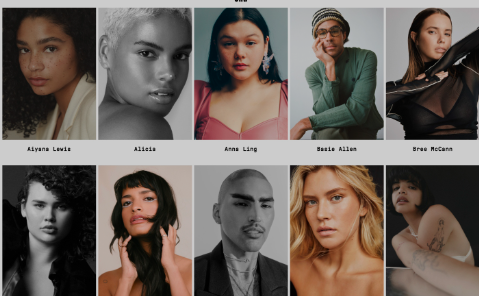The modeling industry, for decades, has been associated with a limited and narrow definition of beauty, often excluding individuals who do not fit conventional standards. However, in recent years, there has been a significant push for more diversity in model casting. This movement, driven by societal changes and a growing awareness of the need for representation, is reshaping the industry. This essay explores the challenges faced, the progress made, and the future perspectives in the ongoing push for diversity in model casting.
I. Historical Context of Model Casting:
- Traditional Beauty Standards:
Historically, the modeling industry has been dominated by a set of traditional beauty standards, favoring a specific body type, skin color, and facial features. This exclusivity created a lack of representation for individuals from various backgrounds and marginalized communities. - Impact on Society:
The perpetuation of narrow beauty standards in model casting has profound implications for society. It not only affects the self-esteem and body image of individuals who do not conform to these standards but also reinforces stereotypes and fosters a sense of exclusion.
II. The Push for Diversity:
- Consumer Demand:
One of the driving forces behind the push for diversity in model casting is the changing demographics and attitudes of consumers. People are increasingly demanding to see themselves represented in advertising and media, leading to a call for greater inclusivity in the modeling industry. - Social Media and Activism:
The rise of social media has given a platform for marginalized voices to be heard. Activists and influencers use these platforms to advocate for diversity and challenge the industry’s status quo. Hashtags like #BodyPositivity and #RepresentationMatters have gained momentum, sparking conversations and holding the industry accountable.
III. Challenges in Achieving Diversity in Model Casting:
- Deep-Rooted Industry Norms:
The modeling industry has been deeply entrenched in longstanding norms that prioritize a specific look. Breaking away from these norms requires a significant shift in mindset, not only among casting directors but also within the broader fashion ecosystem. - Tokenism vs. Genuine Representation:
Achieving diversity is not just about token inclusion but ensuring genuine representation. Some critics argue that, at times, the industry may feature diverse models merely for the sake of appearance, without addressing systemic issues or providing equal opportunities. - Resistance to Change:
Despite the evident demand for diversity, there has been resistance to change within certain segments of the industry. Casting directors and designers may be hesitant to deviate from established norms, fearing potential backlash or commercial risks.
IV. Progress in Diverse Model Casting:
- Increased Visibility:
Over the past few years, there has been a notable increase in the visibility of models from various backgrounds. Major fashion brands and magazines are actively seeking diverse faces, challenging the traditional notions of beauty and setting new standards. - Inclusive Campaigns:
Fashion campaigns and advertisements increasingly feature models of different ethnicities, body sizes, abilities, and gender identities. This shift reflects a conscious effort by brands to appeal to a broader audience and align with contemporary values. - Emergence of Diverse Agencies:
The establishment and success of modeling agencies focused on diversity have played a crucial role in reshaping the industry. These agencies actively seek and represent models from underrepresented communities, creating a more inclusive talent pool.
V. Initiatives and Policies Promoting Diversity:
- Inclusivity Riders:
Some industry stakeholders are advocating for the implementation of inclusivity riders in contracts, which require a certain level of diversity in casting and production. This contractual obligation aims to ensure that the industry takes intentional steps toward inclusivity. - Educational Programs:
Initiatives that educate professionals within the modeling industry about the importance of diversity and the impact of representation are gaining traction. Workshops, seminars, and training programs contribute to creating a more inclusive and aware industry. - Support for Emerging Designers:
Supporting emerging designers who embrace diversity in their collections is a crucial aspect of promoting inclusivity. Industry influencers and organizations are encouraging and rewarding designers who challenge traditional norms and celebrate diversity in their work.
VI. Future Perspectives and Challenges:
- Sustainability of Change:
A critical aspect of the ongoing push for diversity in model casting is ensuring the sustainability of these changes. It requires a commitment from all stakeholders, including casting directors, designers, brands, and consumers, to consistently prioritize inclusivity. - Intersectionality:
Future efforts must address intersectionality, recognizing that individuals may belong to multiple marginalized groups. Ensuring that representation is diverse across race, gender, age, size, and ability will contribute to a more comprehensive and equitable industry. - Global Perspectives:
Achieving true diversity in model casting requires a global perspective. Different regions have distinct beauty standards, and efforts should be made to embrace and celebrate the diversity present in various cultures around the world.
Conclusion:
The push for more diversity in model casting represents a positive and transformative movement within the modeling industry. While significant progress has been made, challenges persist, and ongoing efforts are required to bring about lasting change. The industry’s commitment to breaking away from traditional beauty norms, coupled with initiatives, policies, and changing consumer expectations, will shape a more inclusive and representative future for modeling. As the industry continues to evolve, it is essential to recognize the power it holds in influencing societal perceptions and promoting a more accepting and diverse world.
